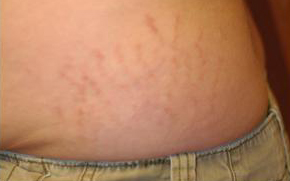Finally, a Real Remedy for Stretch Marks: Dermatology Specialist Joshua Fox, MD, Offers Tips for Understanding the New Laser Treatments for Stretch Marks
![]()
 They’re hardly a serious disease, but those ugly little ridges that dermatologists call striae distensae (and the rest of us call stretch marks) are a serious concern for many women, especially when summer fashions leave more skin exposed. According to Joshua A. Fox, MD, founder and medical director of NY and NJ-based Advanced Dermatology PC., and a leader in treating stretch marks with lasers “previously, they were all but incurable. Almost 20 years ago we were the first to innovate a laser treatment for stretch marks which generated attention from all the major TV channels including CBS, WABC and CNN. Now, with the arrival of today’s new laser treatments, we have even better solutions for treating stretch marks to offer to our patients.”
They’re hardly a serious disease, but those ugly little ridges that dermatologists call striae distensae (and the rest of us call stretch marks) are a serious concern for many women, especially when summer fashions leave more skin exposed. According to Joshua A. Fox, MD, founder and medical director of NY and NJ-based Advanced Dermatology PC., and a leader in treating stretch marks with lasers “previously, they were all but incurable. Almost 20 years ago we were the first to innovate a laser treatment for stretch marks which generated attention from all the major TV channels including CBS, WABC and CNN. Now, with the arrival of today’s new laser treatments, we have even better solutions for treating stretch marks to offer to our patients.”
Explaining Stretch Marks
Stretch marks are scar-like bands that are formed when the skin is stretched beyond its limits in order to accommodate a sudden increase in body size—because of pregnancy, body building, or weight gain, for example—which creates small tears in the skin. Stretch marks can also occur because of hormonal changes (the kind that come with pregnancy and puberty as well as from external agents like hormone replacement therapy and steroidal drugs). Although they can pop up almost anywhere, stretch marks are most likely to occur in areas where the body stores its extra fat, such as the belly, breasts, hips, and thighs (an exception to this rule would be in body builders, who typically get stretch marks in the skin around the bigger muscles, like the biceps). When they’re newly formed, stretch marks look red and shiny, but after a few months will turn a whitish color and often become slightly indented or depressed. While they do become less noticeable over time, once they’re formed, stretch marks are almost always here to stay.
“Even though stretch marks are visible on the skin’s surface, they’re actually formed in the dermis, which is the skin’s middle layer,” says Dr. Fox. That little detail makes them notoriously tough to treat, as topical agents simply can’t penetrate past the epidermis, or outer layer of the skin. “Up until recently, people didn’t have many options,” Dr. Fox says. Prescription medicines like tretinoin (Retin-A) might help a little with the newer marks, but older marks were essentially impervious to creams. “You could waste your money on creams and lotions, have an operation like a tummy tuck, or just live with them.”
But not anymore. Today, doctors can treat stretch marks—even the old ones—with lasers, and achieve very real major improvements after only a few treatments.
Tips for Understanding Pulsed Dye Laser for Treating Stretch Marks
Dr. Fox was the first to report use of a pulsed dye laser to treat stretch marks, and recently demonstrated success in his own research on more than 300 patients. “Our research, along with other published studies, has shown that the pulsed dye laser can be really effective against stretch marks,” he says. “We found that the laser could improve the discoloration and reduce the size and depth of stretch marks and improve the skin’s elasticity by about 50-65 percent, which is a big improvement.” Other research has confirmed these findings, he adds. For example, one study found that treatments combining the laser with a device that administers radiofrequency waves produced measureable improvements in roughly 90 percent of patients tested.
Other lasers are also helpful in treating stretch marks without downtime. One recent study found significant improvement in the light color of stretch marks with the Excimer Laser. We have also found the Fractionated 1550 Fraxel to be quite helpful in lightening up the scar tissue and making stretch marks appear less. All these lasers require no downtime.
The pulsed dye laser administers short bursts (or pulses) of light that specifically target reddish areas in the skin and/or the collagen, and therefore has been used for many years to treat things like enlarged blood vessels, rosacea, and red birthmarks. Moreover, in addition to its ability to treat these conditions, the pulsed dye laser also works to increase both collagen and elastin, two key proteins in the skin responsible for its structure and elasticity.
Dr. Fox notes that new stretch marks can often be significantly or dramatically improved in just one visit, while older marks typically require at least two or three treatments, spaced several weeks apart. Today’s lasers are much easier to handle than earlier models, as they produce much less bruising and almost no pain, just a mild snapping sensation. In addition, pulsed dye laser treatments involve no downtime: Patients can resume all regular activities right away—and get back into those shorts and swimsuits before the summer is out.
